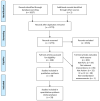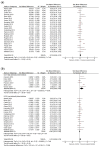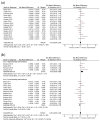The Efficacy of Early Interventions for Children with Autism Spectrum Disorders: A Systematic Review and Meta-Analysis
- PMID: 36079029
- PMCID: PMC9457367
- DOI: 10.3390/jcm11175100
The Efficacy of Early Interventions for Children with Autism Spectrum Disorders: A Systematic Review and Meta-Analysis
Abstract
The superiority of early interventions for children with autism spectrum disorders (ASDs) compared to treatment as usual (TAU) has recently been questioned. This study was aimed to investigate the efficacy of early interventions in improving the cognitive ability, language, and adaptive behavior of pre-school children with ASDs through a systematic review of randomized controlled trials (RCTs). In total, 33 RCTs were included in the meta-analysis using the random effects model. The total sample consisted of 2581 children (age range: 12-132 months). Early interventions led to positive outcomes for cognitive ability (g = 0.32; 95% CI: 0.05, 0.58; p = 0.02), daily living skills (g = 0.35; 95% CI: 0.08, 0.63; p = 0.01), and motor skills (g = 0.39; 95% CI: 0.16, 0.62; p = 0.001), while no positive outcomes were found for the remaining variables. However, when studies without the blinding of outcome assessment were excluded, positive outcomes of early interventions only remained for daily living skills (g = 0.28; 95% CI: 0.04, 0.52; p = 0.02) and motor skills (g = 0.40; 95% CI: 0.11, 0.69; p = 0.007). Although early intervention might not have positive impacts on children with ASDs for several outcomes compared to controls, these results should be interpreted with caution considering the great variability in participant and intervention characteristics.
Keywords: autism spectrum disorders; cognitive ability; early interventions; language; meta-analysis.
Conflict of interest statement
The authors declare no conflict of interest.
Figures












References
-
- Schreibman L., Dawson G., Stahmer A.C., Landa R., Rogers S.J., McGee G.G., Kasari C., Ingersoll B., Kaiser A.P., Bruinsma Y., et al. Naturalistic developmental behavioral interventions: Empirically validated treatments for autism spectrum disorder. J. Autism Dev. Disord. 2015;45:2411–2428. doi: 10.1007/s10803-015-2407-8. - DOI - PMC - PubMed
Publication types
LinkOut - more resources
Full Text Sources

